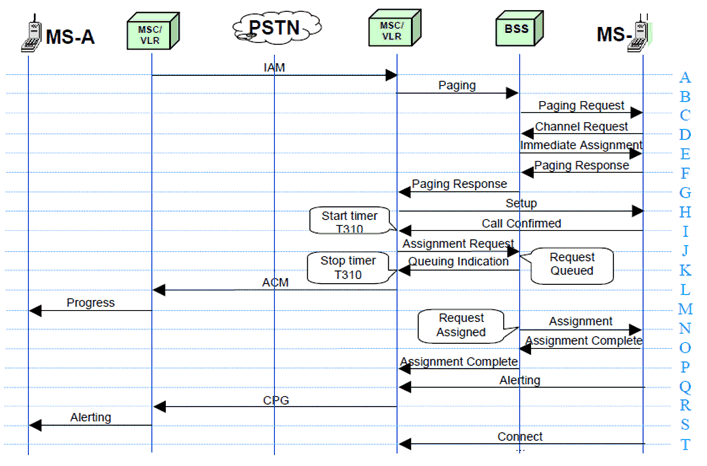Content for TR 22.952 Word version: 18.0.1
0…
4…
4.8…
5
5.1
5.2
5.3
5.4
5.5
5.6
5.7
5.8
5.9
5.10
5.11
5.12
5.13
6…
A…
B
B.1
B.2
B.3
B.4
B.5
B.6
B.7
B.8
B.9
C
D…
5.4 Priority service call termination - radio resources unavailable, call queued p. 22
This clause illustrates a MT Priority Service call establishment with early assignment when an incoming Priority Service call to a wireless called party is received at a terminating MSC. In this scenario, radio traffic channels are not available when the Priority Service call is attempted, the Priority Service request is queued, and call establishment proceeds when a radio traffic channel becomes available.

A-J.
Same as described in steps A-J of Clause 5.2.
K.
As no radio traffic channel is available on receipt of the Assignment Request message, the BSS places the incoming call request in a queue based on the call priority and arrival time. The BSS returns a Queuing Indication message to the MSC/VLR and starts BSSMAP timer T11. The BSSMAP timer T11 specifies the allowed queuing delay for the call and is determined by the Service Provider.
L.
On receipt of the Queuing Indication message, the MSC/VLR stops CC timer T310 and sends an ISUP ACM message to the calling party with Called Party's Status Indicator set to "excessive delay".
M.
In the sub-case of mobile originated calls, on receipt of this ISUP ACM message with Called Party's Status Indicator set to "excessive delay", the originating MSC/VLR stops ISUP IAM timer (T7) and sends a Progress message to the calling MS (MS-A). The Progress message includes the progress indicator information element with progress description set to #64 "Queuing". On receipt of the Progress message, MS-A stops all CC timers related to the call, including CC timer T310.
N.
When an idle radio traffic channel becomes available before BSSMAP timer T11 expires, the BSS stops timer T11, sends an Assignment Command message to MS-B on the main signalling link, and starts BSSMAP timer T10 and RR timer T3107.
O.
On receipt of the Assignment Command message, MS-B initiates the activation of the channels, their connection, and the establishment of the main signalling links. After the main signalling link is successfully established, MS-B returns an Assignment Complete message, specifying cause "normal event", to the network on the main DCCH.
P.
On receipt of the Assignment Complete message, the BSS releases the previously allocated resources, stops RR timer T3107, and stops BSSMAP timer T10. On successful assignment of the required channels, the BSS returns an Assignment Complete message to the MSC/VLR.
Q.
The MS initiates user alerting by generating an appropriate tone or indication at the MS and by sending an Alerting message to the MSC/VLR.
R.
On receipt of the Alerting message, the MSC/VLR starts CC timer T301 and sends an ISUP Call Progress (CPG) message to the calling party with an event indicator set to "alerting" in the Event Information parameter.
S.
In the sub-case of mobile originated calls, on receipt of the ISUP CPG message with an event indicator set to "alerting", the originating MSC/VLR sends an Alerting message to the calling MS (MS-A). The required steps that follow at the calling party are the same as described in steps N-P in Clause 5.1.
T.
MS-B indicates acceptance of a mobile terminating call by sending a Connect message to the MSC/VLR. MS-B starts CC timer T313.
U-V.
Same as described in steps Q-R of Clause 5.2.